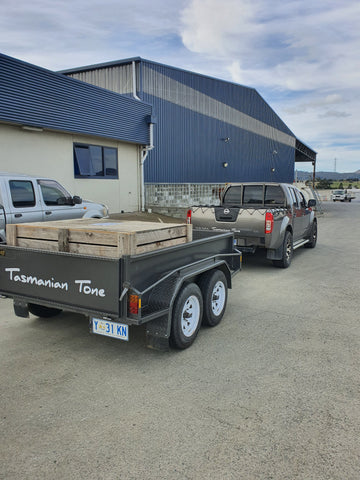About Robert MacMillan

Where do we start?
In between periods of world travel I have been working on and off with timber since falling in love with woodwork as a 12 year old at School, over 60 years ago.
I have always enjoyed turning wood into works of art and sculpture, and most of my close friends are also wood artisans.
I started selectively harvesting and salvaging from old growth rainforests in Tasmania shortly after first arriving in 1968, and I am a great believer that our fine forest minor species timbers should be value added, and our forests should be selectivity harvested and not clear felled. Small diameter trees should be left to grow timber for the future, and large diameter logs should be selected for the best recovery possible.
I have supplied furniture makers, cabinet makers and wood turners for over 30 years, and moved into supplying musical industry manufacturers on a small scale about 1996 which is when Tasmanian Tonewoods first came on to the music scene.
During that time I have met many great luthiers and always listened carefully to what they had to say in order to better understand their requirements and ensure Tasmanian Tonewoods supply their needs in musical timbers. I have always believed that if you want to do something to the best of your ability, listen and learn from your customers.
And that is just what we do here at Tasmanian Tonewoods.
I no longer salvage from the forests myself these days due to old age and worn out body, but I travel between 12.000 and 15.000 kilometres a year visiting private land owners, cattle and dairy farms, and sawmills owned by close friends. Trees are selectively harvested using logging contractors, then delivered to close friends who mill the logs to my requirements, and then the timber is air dried to lose moisture before being re-sawn for musical instruments produced by Tasmanian Tonewoods in our workshop in Bagdad, Tasmania.
Working with close friends Randal Morrison of Tasmanian Special Timbers & Chris Emmett of Island Specialty Timbers and other close friends, between us we have hundreds of years experience in the Tasmanian timbers industry.
All of our timbers are legally harvested.
Tasmanian Tonewoods take great pride in what we do to guarantee that you receive the best Tasmanian Tonewoods available... that is our promise.  Home of Tasmanian Tonewoods Bagdad Tasmania.
Home of Tasmanian Tonewoods Bagdad Tasmania.
Tasmanian Salvaged Resurrection Timbers specialises in providing you with highly figured Tasmanian exotic hardwoods. These rare and beautiful woods are sought after by stringed instrument makers, Intarsia craft, cabinet makers, and box makers world wide. If you want timber for that special project or one of a kind build, please contact us: robert@tasmaniantonewoods.com.au

Robert On the left with Rick Turner of Rick Turner guitars.

Left to Right: Andy Powers head luthier with Taylor guitars; Robert of Tasmanian Tonewoods; Chris Cosgrove Wood buyer for Taylor guitars.

Robert of Tasmanian Tonewoods deep in a rainforest in Warratah, Tasmania, inspecting an ancient Tasmanian Myrtle.

Above: Mathew my right hand man processing a billet on jointer before resawing for musical instrument Tonewoods.
Below: Studying a Tasmanian Eucalyptus burl before resawing tops for Bass and electric guitars.

Robert Salvaging - Mount Mueller spur 3, Styx Valley.


Robert as a young hippy, with his dog "Husky".

Delivering an order to Tasfreight trucking company for transport to Melbourne for fumigation, then on it's way to the UK.



Robert, on the way home with salvaged Myrtle burl.

Robert of Tasmanian Tonewoods with Paul Gilbert guitarist and Co founder of heavy metal band Mr Big.


Need to make a payment?
Customer Gallery
Check out the customer instrument Gallery - Instruments on display were built by customers using tonewoods supplied by Tasmanian Tonewoods
Why use wood?
Timber is a natural material which is naturally renewable as a resource. It is probably the most versatile material known to man. It has a high strength to weight ratio and good thermal properties. It can be sawn, riven, drilled, carved and turned. Generally, it is easily glued. Sawing across or along the grain will expose differently pleasing features of the same species. Timber can be finished by sawing, planning, or sanding and polished, painted, oiled or varnished, any of which can enhance the natural product in different ways.
Timber can be naturally preserved by drying, but if the species is susceptible to rotting as some narrow leafed species can be, it can be preserved by pressure impregnation of chemicals. There is a market today in all waste products accumulated from the production of timber products.
There is much debate today over the conservation of forests worldwide and the use of timber. Trees should be regarded as a crop and as such should be harvested at maturity, so that a natural resource is not wasted. This should be followed by replanting and commercially efficient husbandry to complete a full cycle.
Whilst widespread devastation of forests should be deplored, it should also be remembered that a selective felling policy does not destroy the forest and allows natural regeneration giving employment to many and valuable foreign currency for exporting countries.
Wood is aesthetically pleasing with totally natural characteristics and a multitude of beautiful colours, textures, properties and strengths which have never been successfully copied with modern materials.
